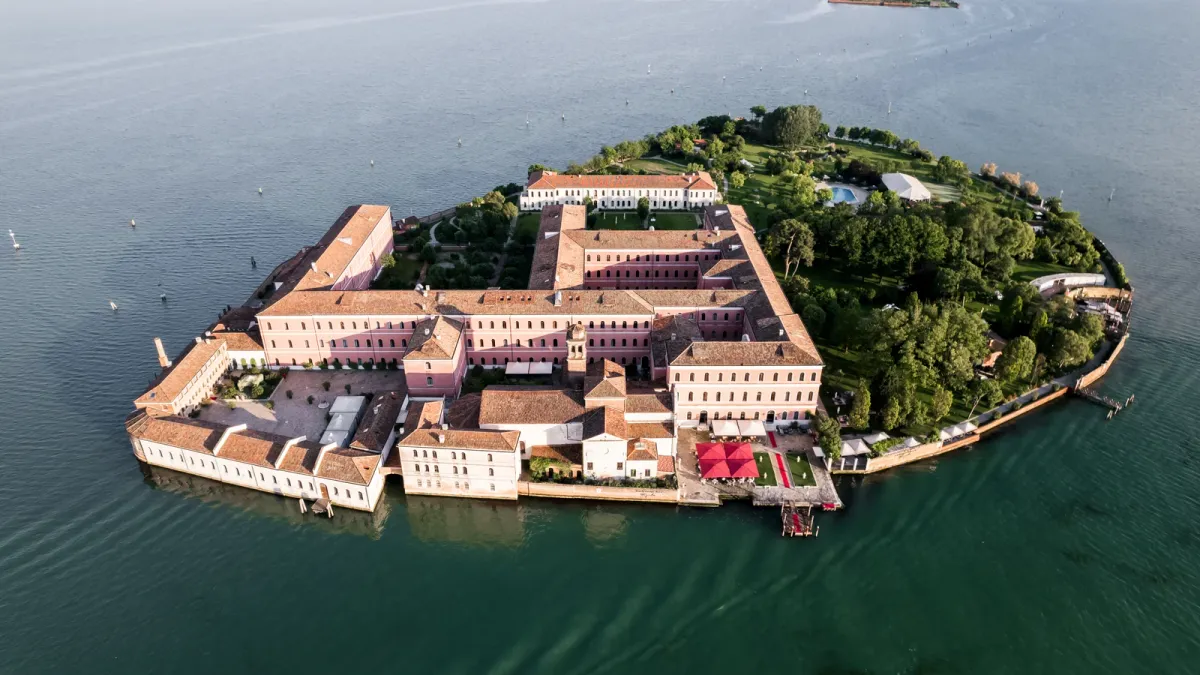Mandarin Oriental takes over Venice's historic San Clemente Palace from Kempinski, planning extensive renovations before reopening in April 2026. The 900-year-old property is Venice's only luxury island resort, just 8 minutes from Piazza San Marco.
Mandarin Oriental has secured management of the historic San Clemente Palace in Venice, marking a pivotal expansion into one of Italy's most coveted luxury hotel markets. This strategic acquisition strengthens the Asian hospitality giant's European footprint while positioning them to capitalize on Venice's booming luxury tourism recovery, with the property set to undergo a transformative renovation before reopening as "Mandarin Oriental, Venice" in April 2026.
The management transition represents a significant victory for Mandarin Oriental's ambitious growth strategy under CEO Laurent Kleitman, who aims to double their portfolio to 80-100 properties by 2034. Adding Venice to their Italian circuit alongside existing properties in Milan and Lake Como creates a powerful luxury tourism trifecta, while planned openings in Rome, Cortina, and Porto Cervo will establish MO as Italy's premier international luxury hotel operator.
A 900-year-old island sanctuary changes hands
The San Clemente Palace occupies a private 6-hectare island in the Venetian Lagoon, just eight minutes by boat from Piazza San Marco. Originally founded in 1131 by Venetian merchant Pietro Gattilesso as a monastery and pilgrim hospice, the property has served as the "Gateway to Venice" for nearly nine centuries. The 12th-century Church of San Clemente and restored monastery buildings create an irreplaceable setting that combines historical authenticity with luxury exclusivity.
Under Kempinski's nine-year management (2016-2025), the property earned exceptional recognition as the World's Leading Hotel for three consecutive years (2023-2025) and Europe's Leading Luxury Island Resort. The German luxury brand successfully positioned San Clemente as Venice's premier resort-style destination, offering amenities unavailable elsewhere in the city including a heated outdoor pool, tennis court, and extensive gardens spanning nearly 20 acres.
Kempinski's tenure was marked by significant operational achievements, including the introduction of the award-winning Merchant of Venice SPA and consistently high guest satisfaction ratings. The property's 196 rooms and suites established it as one of Venice's largest luxury hotels, while its unique island location provided the privacy and space that mainland Venice hotels cannot offer.
Mandarin Oriental's Italian expansion accelerates
"We are delighted to bring Mandarin Oriental's legendary service to Venice," said Laurent Kleitman, Group CEO of Mandarin Oriental. "This historic property, with its unique location and rich heritage, aligns perfectly with our vision to craft immersive experiences that allow guests to connect meaningfully with the destination."
The acquisition fits seamlessly into Mandarin Oriental's broader European expansion strategy, which has added properties in Paris, Amsterdam, Zurich, Geneva, Prague, Madrid, and Munich in recent years. The company's asset-light management approach allows them to secure premium properties without massive capital investment, instead partnering with sophisticated property owners like Permak Investments, the Turkish conglomerate that has owned San Clemente since 2013.
Emir Uyar, Vice President of Permak Investment, emphasized the strategic partnership: "We are delighted to partner with Mandarin Oriental to usher in a new era for the San Clemente Palace. As one of Venice's most storied private islands, this landmark deserves the legendary service and refined hospitality that Mandarin Oriental is renowned for."
The timing capitalizes on Italy's luxury hotel investment boom, with €2.1 billion invested in Italian luxury hospitality in 2024 alone. Venice specifically saw €353 million in hotel investments, making it the second-highest investment destination after Rome.
Transformation planned for Venice's only luxury island resort
Mandarin Oriental will operate the hotel through its November 2025 seasonal closure, followed by an extensive three-phase renovation designed by London-based Albion Nord design studio. The property will reopen in April 2026 as "Mandarin Oriental, Venice" with significant enhancements that blend Venetian heritage with MO's signature aesthetic.
The renovation will reduce room count from 196 to 136 elegantly appointed rooms and suites, creating more spacious accommodations and premium positioning. New amenities will include four distinctive dining venues reflecting Mandarin Oriental's gastronomic approach, plus The Spa at Mandarin Oriental featuring multiple treatment rooms, Finnish sauna, steam bath, and multi-sensory showers.
Additional planned features include a dedicated yoga pavilion, enhanced outdoor pool area, tennis and paddle courts, and expanded event spaces that will leverage the property's unique island setting. A dedicated children's area targets the luxury family market, while the historic 12th-century church will continue serving as an exclusive wedding venue.
The design philosophy emphasizes preserving the property's 900-year heritage while incorporating Mandarin Oriental's refined Asian hospitality approach. This cultural fusion represents a compelling value proposition in Venice's competitive luxury market, offering guests both authentic Venetian atmosphere and internationally recognized service standards.
Venice's luxury hotel market reaches new heights
The management transition occurs during a remarkable recovery period for Venice's luxury hospitality sector. Upper upscale and luxury properties have not only recovered from pandemic impacts but are achieving average daily rates 40% higher than 2019 levels. Industry analysts note that luxury hotels are significantly outperforming the overall Venice hotel market, which remains 10.3% below pre-pandemic levels.
San Clemente's unique positioning as Venice's only private island luxury resort provides natural differentiation in an increasingly competitive market. Recent luxury hotel developments include Les Airelles' renovation of former Bauer assets, The Langham Venice converting a Murano Island glass factory, and Four Seasons' rumored interest in prestigious canal-front properties.
The broader global luxury hotel market is experiencing robust growth, with industry projections showing 7.5-11.5% compound annual growth rates through 2030. This expansion is driven by increasing demand for experiential luxury travel and unique, culturally immersive accommodations - exactly what San Clemente Palace offers with its combination of historical significance and resort amenities.
Hospitality analysts view the Mandarin Oriental transition as validation of luxury hotel brand consolidation trends, where established international operators secure premium assets through management agreements. This strategy provides operational scale advantages while maintaining local character and authenticity.
Strategic implications for luxury hospitality
Industry experts interpret this management change as part of broader luxury hotel consolidation patterns, where major brands acquire premier properties to strengthen portfolio positioning and resist commoditization pressures from online travel agencies. Mandarin Oriental's asset-light expansion strategy allows rapid growth without massive capital requirements, instead leveraging their operational expertise and brand recognition.
The Venice acquisition particularly strengthens Mandarin Oriental's European destination clustering strategy. Creating multiple properties within driving distance - Milan, Lake Como, and now Venice - enables cross-selling opportunities and extended luxury itineraries for high-net-worth travelers. Planned Italian openings in Rome, Cortina, and Porto Cervo will further enhance this geographic concentration.
For Venice's tourism industry, adding another globally recognized luxury brand enhances the destination's premium positioning while providing additional options for ultra-high-net-worth visitors. The property's island location also offers a solution to overtourism concerns, providing luxury accommodations outside the crowded historic center while maintaining convenient access.
Conclusion
Mandarin Oriental's acquisition of the San Clemente Palace management contract represents a masterful strategic move that secures an irreplaceable luxury asset during Venice's tourism recovery. The property's unique combination of 900-year history, private island exclusivity, and resort-style amenities creates natural competitive advantages that support premium pricing power.
The extensive renovation and April 2026 rebranding will position the property to capitalize on growing demand for experiential luxury travel while strengthening Mandarin Oriental's European presence. With Venice's luxury hotel market performing exceptionally well and limited new supply available, this acquisition provides MO with a rare opportunity to establish dominance in one of the world's most desirable destinations.
The successful integration of San Clemente Palace will serve as a model for Mandarin Oriental's continued expansion strategy, demonstrating how established luxury brands can enhance unique properties while preserving their authentic character and historical significance.


